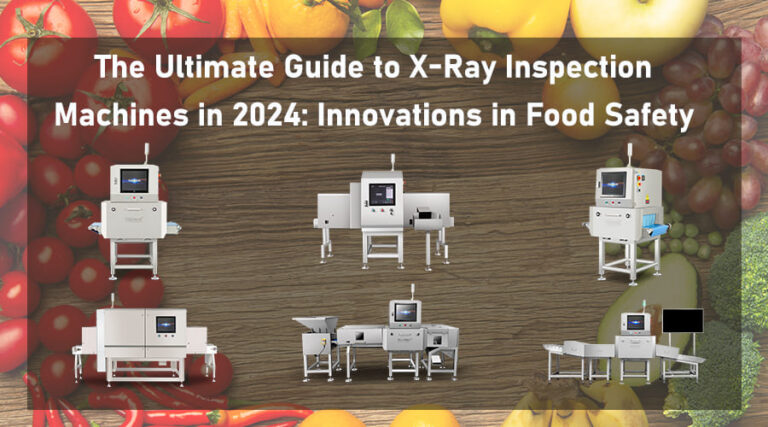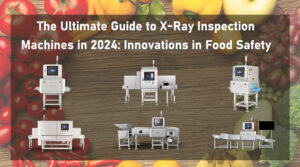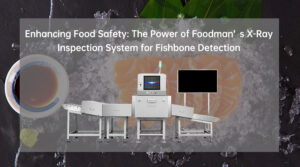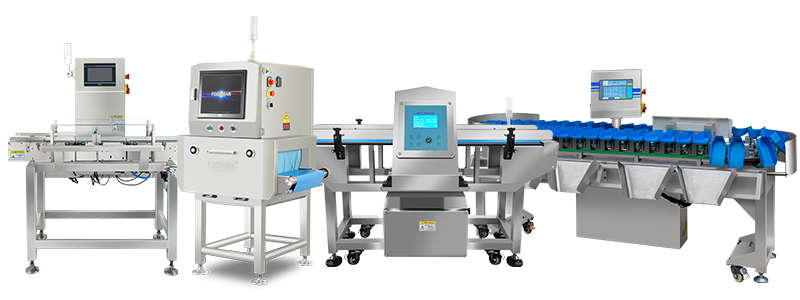Introduction
In 2024, ensuring food safety is more critical than ever, and X-ray inspection systems are the way forward to safeguarding the food supply chain. As the industry evolves, so does the need for advanced detection solutions to meet increasingly stringent safety standards.
X-ray inspection machines have proven essential in protecting consumers from hidden contaminants, like small bones, metals, and other foreign objects that could pose health risks. Foodman, a leader in the X-ray inspection industry, is at the heart of this technological advancement. Through next-gen innovations and state-of-the-art machines equipped with dual-energy capabilities and AI technology, Foodman is revolutionizing contaminants detection and food safety.
This article explores the importance of X-ray inspection systems for food safety in 2024. It also highlights the role Foodman is playing in pushing the industry forward and provides insight into the latest technological advancements shaping the future of food safety.
Understanding X-Ray Inspection Machines in 2024
As the food industry continues to advance, the need for precise and reliable inspection methods becomes paramount. In 2024, X-ray inspection machines are already at the forefront of this evolution, integrating cutting-edge technology to maintain stringent food safety requirements. These machines detect a wide range of contaminants—including bones, metal fragments, and other foreign objects—ensuring that food products meet industry safety standards.
Today’s food X-ray systems improve detection accuracy and bring heightened efficiency and versatility to food processing facilities. Many food manufacturers now consider them essential tools for quality control across various sectors, including meat, fish, and bulk food processing.
What Is an X-Ray Inspection Machine and How Does It Work?
An X-ray inspection machine is a nondestructive testing device for identifying physical contaminants in food products. The X-ray technology captures high-resolution images of food items, allowing operators to spot foreign materials, including bones, metals, plastics, and other particles that could compromise safety.
The machine emits X-rays that penetrate the food product and capture variations in density. Denser materials, like bones or metals, feature a distinctive appearance on the X-ray image, indicating to the operator that they are contaminants.
The process is swift and automated, making it suitable for large-scale food production. Moreover, food manufacturers and processors can customize these machines to inspect specific food types and meet specific compliance standards, ensuring a safer product for consumers.
What Innovations Does the 2024 X-ray Machine Have?

The 2024 X-ray inspection machines introduce significant advancements over basic models from previous years. These devices typically focus on detecting foreign objects like metals and small bones. While earlier machines were effective for basic safety checks, they are limited in detecting smaller, more calcified bones or contaminants embedded in denser meat and fish.
In 2024, Foodman set a new industry standard with two advanced systems: the Foodman X-ray inspection system for fishbone and the Foodman dual energy X-ray inspection for bones. The fishbone detection system uses enhanced imaging tech to detect thin, translucent fishbones. This makes the device common in seafood processing, improving safety in fish products like salmon and tuna. This precision technology is crucial for meeting the strict requirements of today’s food safety standards.
In addition, X-ray detect hard bones, distinguishing small, calcified bones and other dense contaminants in meat products. This system utilizes dual energy wavelengths, isolating and identifying bones of various densities while reducing false positives. Equipped with Foodman’s proprietary FDX technology and an intelligent algorithm platform, this machine learns from inspection data to continuously improve accuracy.
Innovations in X-Ray Inspection: Dual Energy Technology
Dual energy food X-ray technology represents a major leap forward, addressing challenges that traditional X-ray systems cannot. This device is revolutionary, enhancing food safety for the public. Unlike the traditional X-ray inspection device, this innovative technology uses two energy levels instead of one.
The different energy levels offer better detection capabilities, using varying densities to screen hidden contaminants that may compromise safety. This technology offers a new level of reliability, especially valuable in meat and fish processing, where even small bones pose significant risks. The X-ray detects fish bone, stones, plastic, and other complex contaminants.
What Is Dual Energy X-Ray Inspection for Bones?: A New Standard for Accurate Detection
As mentioned above, dual energy X-ray inspection is designed to improve accuracy in identifying contaminants based on their density and composition. Unlike traditional X-ray systems, which use a single energy spectrum to detect objects, dual energy systems employ two distinct energy levels.
This duality allows for a clearer contrast between organic materials like bones and other substances within the food. The result is a more precise differentiation of small, calcified bones from the surrounding meat or fish, helping producers meet stringent food safety guidelines.
Dual Energy X-Ray vs. Standard X-Ray Inspection: What You Need to Know
While standard X-ray inspection systems rely on density differences to identify foreign objects, they can struggle with small or embedded bones. This difficulty is particularly pronounced when inspecting dense or layered food products.
However, dual-energy technology’s ability to utilize both high- and low-energy X-rays allows it to produce a more nuanced image, highlighting even subtle compositional differences. This enhanced capability reduces the chances of false negatives, enabling a more consistent detection across various food products.
How Dual Energy Technology Detects Smaller and Hard-to-See Contaminants
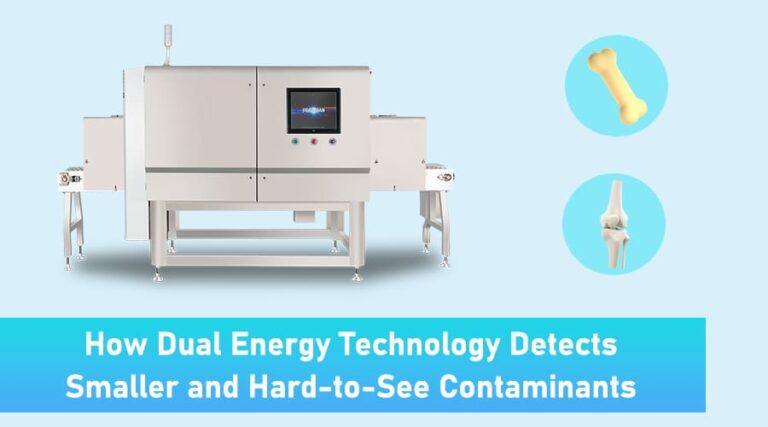
As mentioned, dual-energy X-ray technology can detect difficult-to-spot contaminants, such as smaller bones embedded deep within fish and meat products. This feature is one of its most prominent advantages. So, how does the device achieve this?
It integrated cutting-edge AI technology and intelligent algorithm platforms to optimize accuracy. The AI system continuously learns from inspection data, allowing it to adapt to different food textures and compositions. The Foodman dual-energy X-ray inspection system is a typical example of this device. Besides the standard AI and smart learning capabilities, the Foodman dual-energy X-ray device utilizes a proprietary technology—FDX (Full Dynamic X-ray).
The FDX technology is a sophisticated imaging method that improves the detailing and clarity of X-ray images. It allows the device to capture high-contrast images of food products, revealing bones and other hard-to-see contaminants with remarkable clarity. This advanced combination ensures high sensitivity to even the smallest contaminants, making it one of the most effective solutions for modern food inspection needs.
Ensuring Product Safety and Compliance in 2024
The standard for food safety has never been higher. Regulatory bodies now have strict regulations requiring that all food products released into the market be of the highest standard. Therefore, food manufacturers and processors must improve quality control measures beyond traditional inspection methods, such as metal detectors and weight graders.
In fact, with increasing technological advancements, standard X-ray machines are becoming obsolete. Unlike the newer dual-energy X-ray inspection systems, they struggle to detect contaminants like bones in fish, meat, and bulk food processing. Therefore, there’s a growing reliance on the latest X-ray inspection technology to meet revised regulatory standards. The dual-energy X-ray device ensures that food manufacturers protect consumers from potential hazards while also enhancing food safety measures for the general public.
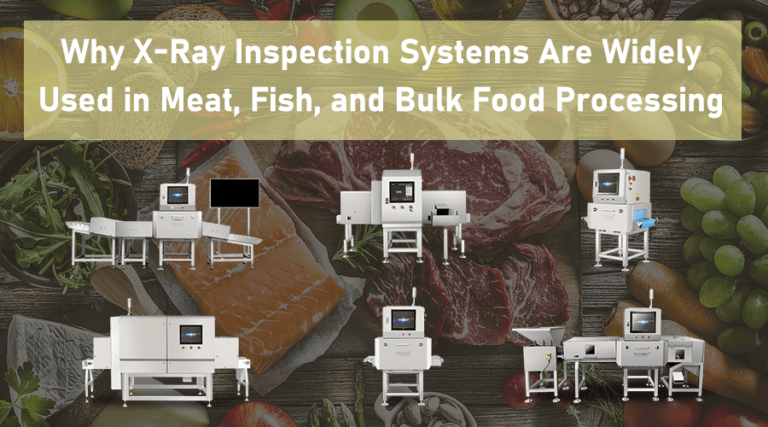
As mentioned above, the regulatory landscape in the food industry continues to tighten, with various agencies worldwide setting increasingly rigorous standards. Therefore, investing in X-ray inspection technology is a proactive step for food producers to stay compliant and avoid costly recalls or penalties. Unlike metal detectors, which only identify metallic objects, X-ray systems can detect a broader range of foreign materials, including bone fragments, dense plastic, and glass, ensuring a higher level of safety.
Moreover, X-ray technology’s ability to capture detailed images at high speed allows manufacturers to maintain productivity while upholding safety standards. This versatility makes it a valuable asset for companies looking to enhance operational efficiency and regulatory compliance.
A food X-ray machine is more than just a contaminant detector—it’s a crucial component in quality assurance. By scanning products at various stages of production, X-ray inspection systems provide a comprehensive evaluation of the food’s internal structure, identifying contaminants and product inconsistencies. This ensures that only high-quality items reach consumers.
In addition, it incorporates features like advanced AI-driven algorithms and intelligent analysis platforms, ensuring the identification of impurities undetectable by regular detection devices. A typical example is the Foodman’s dual energy X-ray inspection, which can detect small, calcified bones, stones, plastics, and other hard-to-detect contaminants.
Future Trends: What’s Next for X-Ray Inspection Technology in 2024 and Beyond
With advancements in artificial intelligence, machine learning, and dual energy technology, X-ray inspection systems are moving beyond simple contaminant detection. They are now the the mainstay for ensuring comprehensive quality control. These trends are shaping the industry today and paving the way for future innovations that will redefine how food safety is managed.
How X-Ray Inspection Machines Are Shaping the Future of Food Safety in 2024
X-ray inspection machines are revolutionizing food safety by bringing new levels of precision and automation to the detection process. The device provides the operator with real-time data analytics of the food products it scans, ensuring quicker detection of impurities without compromising accuracy.
Therefore,, as consumer demand for safer, higher-quality food grows, companies increasingly turn to these advanced technologies to meet regulatory and consumer standards. In today’s market of 2024, the adoption of X-ray inspection technology is expected to become even more widespread.
The innovations focus on increasing system adaptability and performance across diverse food products. Therefore, whether used to detect small calcified bones in meat, foreign particles in bulk food, or dense contaminants in fish, X-ray machines are rapidly becoming the backbone of modern food safety protocols.
The Future of Dual Energy X-Ray Inspection and Its Impact on Food Safety
Dual energy X-ray inspection is at the forefront of the next generation of food safety solutions. This technology’s ability to detect smaller, calcified bones and other hard-to-spot contaminants has raised the bar for inspection standards. With enhanced accuracy and adaptability, dual energy X-ray systems can distinguish between materials of different densities more effectively, identifying even subtle anomalies within bulk food items. This is particularly valuable in products like fish and poultry, where bones and other contaminants can be challenging to detect.
Looking ahead, innovations such as Foodman’s Dual Energy X-Ray Inspection’s FDX technology and the intelligent algorithm platform are expected to drive further improvements in food safety.
These advancements enable X-ray systems to adapt to diverse inspection needs. In addition, AI-based learning enhances detection capabilities over time, increasing the accuracy and efficiency of inspections. As dual energy technology becomes more sophisticated, its impact on food safety will only deepen, providing companies with a reliable, scalable solution for maintaining rigorous quality standards well into the future.
Conclusion
X-ray inspection systems are revolutionizing food safety in 2024 by offering unmatched precision in detecting contaminants and ensuring product quality. These systems are setting new industry standards with innovations like dual energy technology, AI integration, and adaptable inspection capabilities.
Foodman leads this evolution, providing state-of-the-art solutions that enhance safety and compliance across meat, fish, and bulk food processing sectors. As we look to the future, X-ray technology will continue to shape the food industry, delivering improved safety, efficiency, and consumer confidence.

